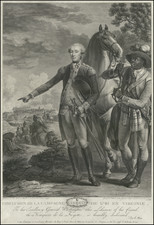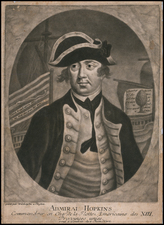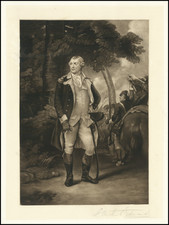Scalp Dance of the Hidatsa Near Fort Clark on the Upper Missouri
A fine hand-colored plate by Karl Bodmer, based on Hidatsa scalp dances witnessed by the artist in 1834 in the Upper Missouri near Fort Clark in present-day North Dakota. The Hidatsa were also called the Minataree (″to cross the water″) by their Mandan allies. The complicated subject is a beautifully composed image of movement and drama in the Upper Missouri.
This view was originally issued as Tableau 27 of Prince Maximilian of Wied-Neuwied's monumental pictorial work of the American West, Reise in das innere Nord-America in den Jaren 1832 bis 1834, or Travels in the Interior of North America, 1832-34, which was illustrated with aquatint engravings after Karl Bodmer's magnificent original art work. The work included detailed and accurate depictions of the landscapes, peoples, and cultures encountered by Bodmer during his journey, and is considered an important record of the American West during this time period.
This scene was based on Bodmer's witnessing two Hidatsa scalp dances at Fort Clark, on February 1 and April 8, 1834. According to Brandon K. Ruud, several individuals in the scene are identifiable:
The figure in the exteme left is a reverse portrait of Síh-Sä, to his left is Ahschüpsa Masihichsi; and next is Biróhkä. Others in attendance include Awascho-Dickfas, whose back is to the viewer in the immediate foreground; Máhschsi-Níhka, who turns toward the viewer in the right foreground; and a man at extreme right whose robe and hair ornaments resemble Síh-Chidä's. Finally, the seated and enshrouded man in the foreground at Síh-Chiä's feet is similar to one also featured in Tableau 26...The remaining figures in the middle distance and background are from Bodmer's on-site drawings of the event... Maximilian wrote that many Mandans had attended the ceremony... The location suggests a village, although Maximilian and Bodmer saw the ceremony at Fort Clark.
Maximilian’s American travel account first appeared in German (1839-41), followed by a French translation in 1840-43 and an English edition in 1843. The Paris-issued pictorial atlas contained eighty-one aquatint plates (48 "imperial" folios and 33 smaller "vignette" plates often called quarto in size), engraved and etched on metal sheets, after paintings by Karl Bodmer, and which accompanied all three editions. The plates are outstanding authentic depictions of the western plains and Native Americans by a highly skilled European artist. Bodmer avoided romanticizing his subjects, and attempted to record the people and places he encountered as true to life as possible.
The present print is a 1922 restrike from the original plate done in Leipzig by Schmidt & Guenther, issued on thicker vellum paper than the 19th century examples.









![(Texas - Comanche Indian Photograph) Tush=a=wa or Whiteknife, Pen=a=teth=ka, Comanche Chief [Cabinet card photograph of Tosahwi, White Knife, or Tosawa; Penateka Comanche Chief]](https://storage.googleapis.com/raremaps/img/small/93032.jpg)
![[Florida Indians / Hermaphrodites] Hermaphroditorum officia. XVII.](https://storage.googleapis.com/raremaps/img/small/97966.jpg)
![[ Native Mexican Warrior ] Ein Mexicaner](https://storage.googleapis.com/raremaps/img/small/94089.jpg)


